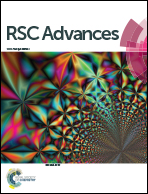Band gap engineering of ZnO substituted with nitrogen and fluorine, ZnO1−3xN2xFx: a hybrid density functional study
Abstract
A series of first principles calculations within density functional theory (DFT) have been performed for ZnO, co-doped with N and F with the aim of engineering the band gap and improving its application to photo-absorption activity. A reliable hybrid functional of Heyd, Scuseria and Ernzerhof (HSE) has been used in order to predict the properties of ZnO1−3xN2xFx. We describe a site disordered solid based on the consideration of configurational ensembles and statistical mechanics. The co-doped ZnO energy band gap shrinks and hence the photo absorption activity is enhanced by a considerable amount. The valence band maxima (VBM) of ZnO is dominated by O-2p orbitals with a considerable contribution from Zn-3d states. In co-doped ZnO1−3xN2xFx just above the VBM a new band appears which is mainly composed of N-2p orbitals. The calculated formation energy ΔHf for ZnO, in zinc rich and oxygen rich conditions are in good agreement with previous results. The calculated binding energies suggest that the stability of ZnO1−3xN2xFx deteriorates at very dilute concentrations suggesting the use of heavy doping is desirable. Our results are helpful in understanding the growth conditions, electronic and optical properties of co-doped ZnO.


 Please wait while we load your content...
Please wait while we load your content...